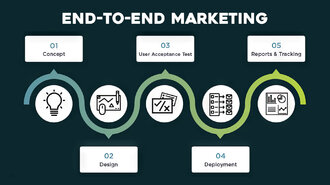These days, marketing attribution is crucial yet more complex than ever. With various channels and consumer behaviours, understanding it is vital for businesses looking to optimise their strategies and boost returns.
Long ago, marketing attribution was considered a simple funnel, but the influx of devices, marketing channels and changing consumer behaviour has added layers of complexity. Concurrently, tracking data has become easier; in fact, numerous data-driven firms utilise marketing attribution mechanisms and technologies to evaluate the efficacy of their digital platforms, emphasising marketing and sales channels.
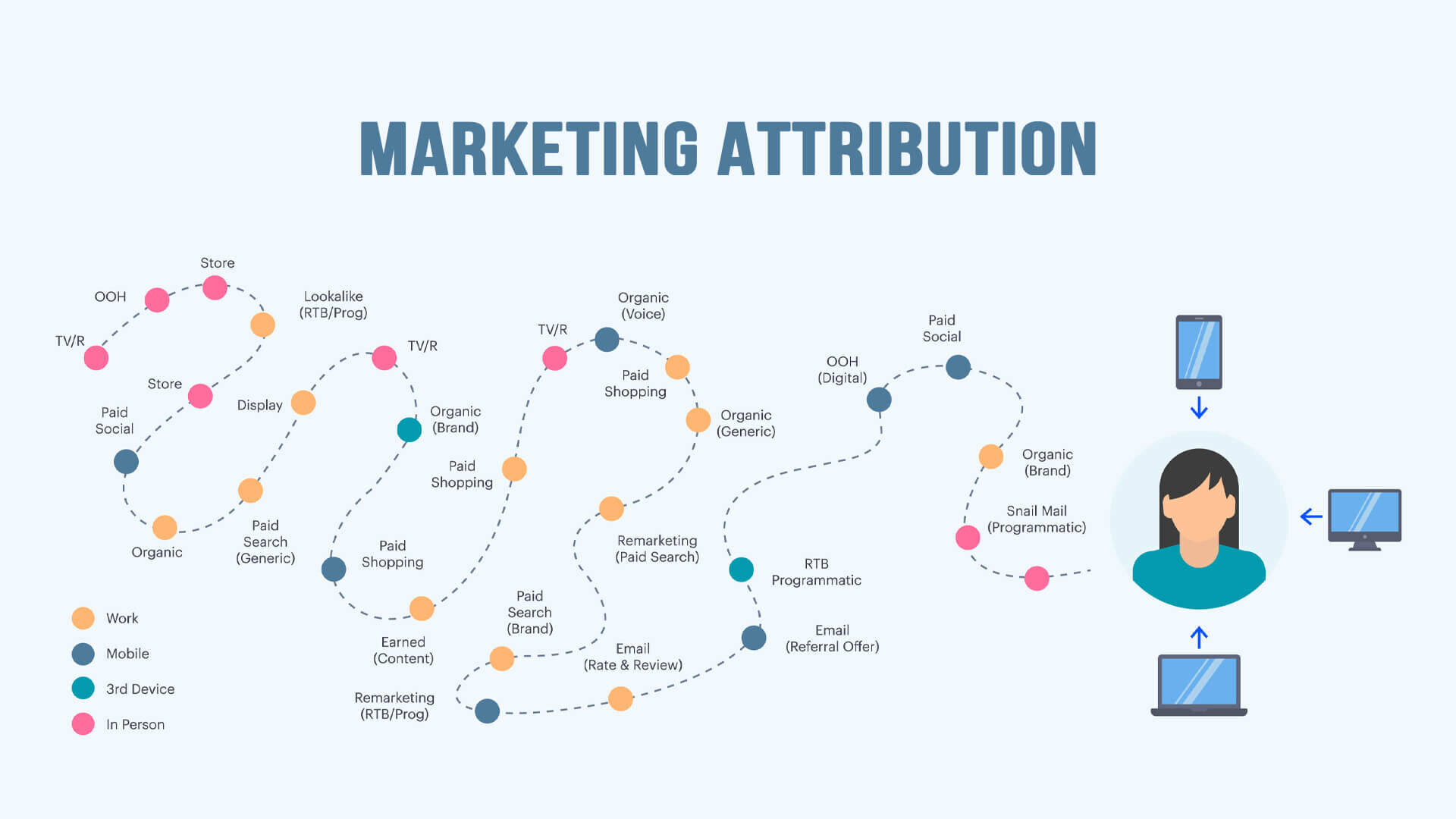
By considering all the touchpoints a customer interacts with, marketing attribution helps businesses pinpoint which channels drive the most conversions. This clarity can be invaluable for refining marketing strategies.
As a business proprietor with limited digital marketing knowledge, comprehending which attribution modelling approach would yield the most beneficial outcomes can be challenging. Hence, we decided to put together a guide on the subject. Continue reading to learn the basics of marketing attribution!
Want to receive updates? Sign up to our newsletter
Each time a new blog is posted, you’ll receive a notification, it’s really that simple.
What Is Marketing Attribution?
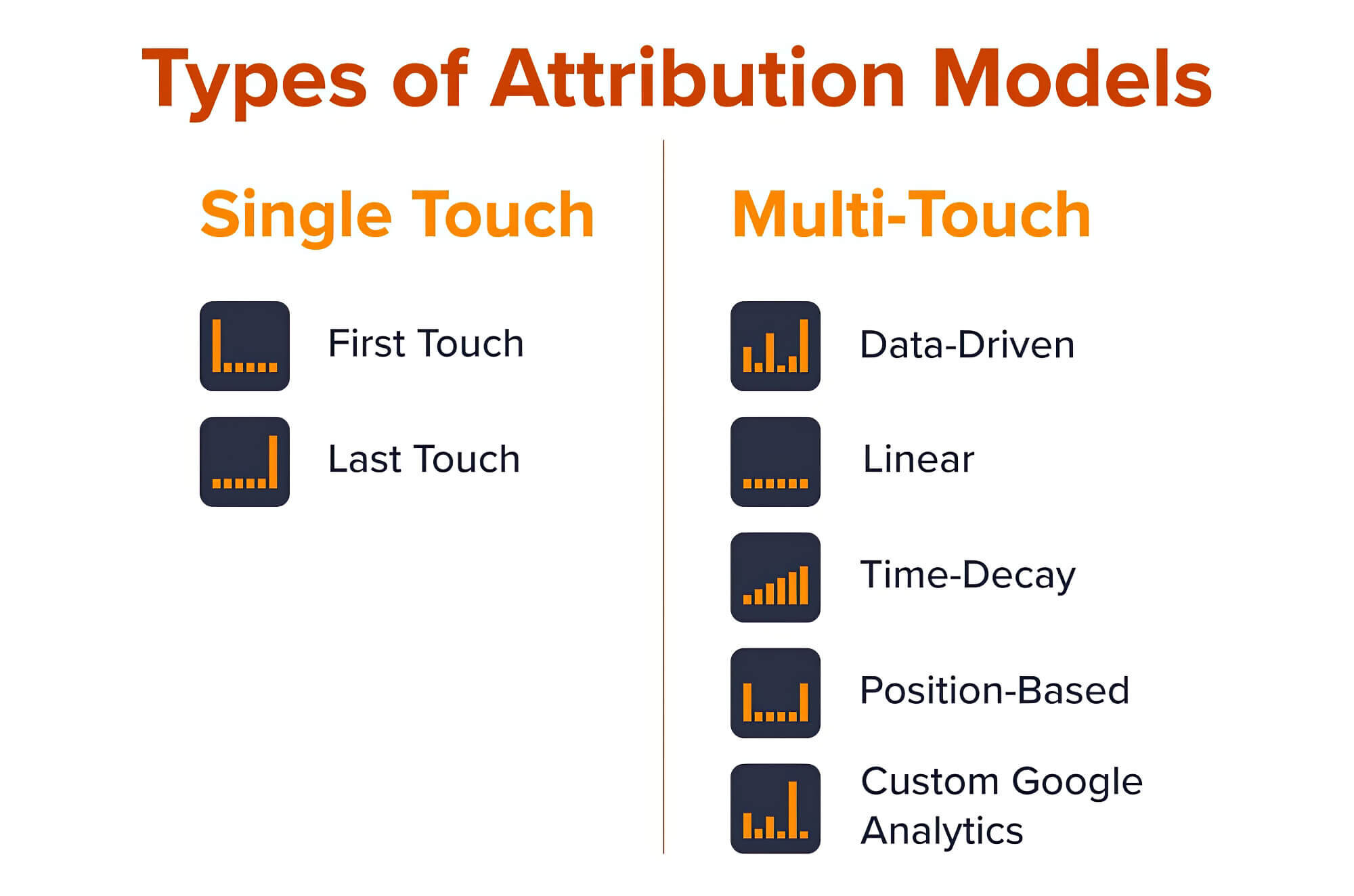
The practice of evaluating and measuring the efficacy of various marketing channels is referred to as marketing attribution, a core component of marketing mix modelling. In other words, it’s a practice through which advertisers identify how marketing efforts and subsequent customer interactions lead to conversions or sales.
Marketing attribution data assists businesses in pinpointing the messages and channels, both online and offline, that influence potential customers to act. Marketing attribution aims to enhance understanding of all customer interactions and touchpoints with your brand, thereby pinpointing the most valuable marketing channels leading to conversions.
A. Different Types Of Marketing Attribution Models
Attribution models are tools that help marketers and business owners understand how users engage with their strategies across various channels before becoming customers. They offer insights into each channel’s impact and the total conversions generated.
Marketers should know about seven different attribution models in the marketing world. But there’s no single ‘right’ model—the best choice hinges on your business goals. It’s essential to pick one that aligns with what you aim to achieve.
That said, let’s check out the different types of attribution models.
1. First Click Attribution
As implied by its name, the first interaction attribution model attributes the entirety of conversion credit to the initial marketing channel with which a visitor engages. Examples of first-click attribution are Facebook ads and downloadable resources like datasheets.
This simple-to-understand and easy-to-implement model overlooks the campaign and eventually results in conversion with each interaction after the first click.
Pros
- Focused on demand generation instead of conversions
- Works well for businesses with short buying cycles
Cons
- It is difficult to determine which campaigns resulted in conversions
2. Last Click Attribution
Unlike the first-click model, the last-click attribution model assigns all conversion credits to the last interaction or click a visitor made before purchasing, giving full credit to the last touchpoint. While using this model, marketers will gain an understanding of the campaigns with the highest conversion rates. Concurrently, they must catch up on the factors that may have contributed to the conversion.
Pros
- Beneficial for businesses that rely solely on driving conversions.
- Easy to implement and evaluate
Cons
- Disregards the influences on the conversion path.
3. Linear Attribution
The linear attribution model gives equal conversion credit to all touchpoints. If there are ten touchpoints in a customer’s journey, each touch will receive 10% of the conversion credit.
Pros
- A comprehensive picture of marketing performance and customer interactions
- Helps optimise the entire customer journey
Cons
- It doesn’t allow businesses to optimise for certain outcomes.
- Equal credit is assigned to low-value clicks like email.
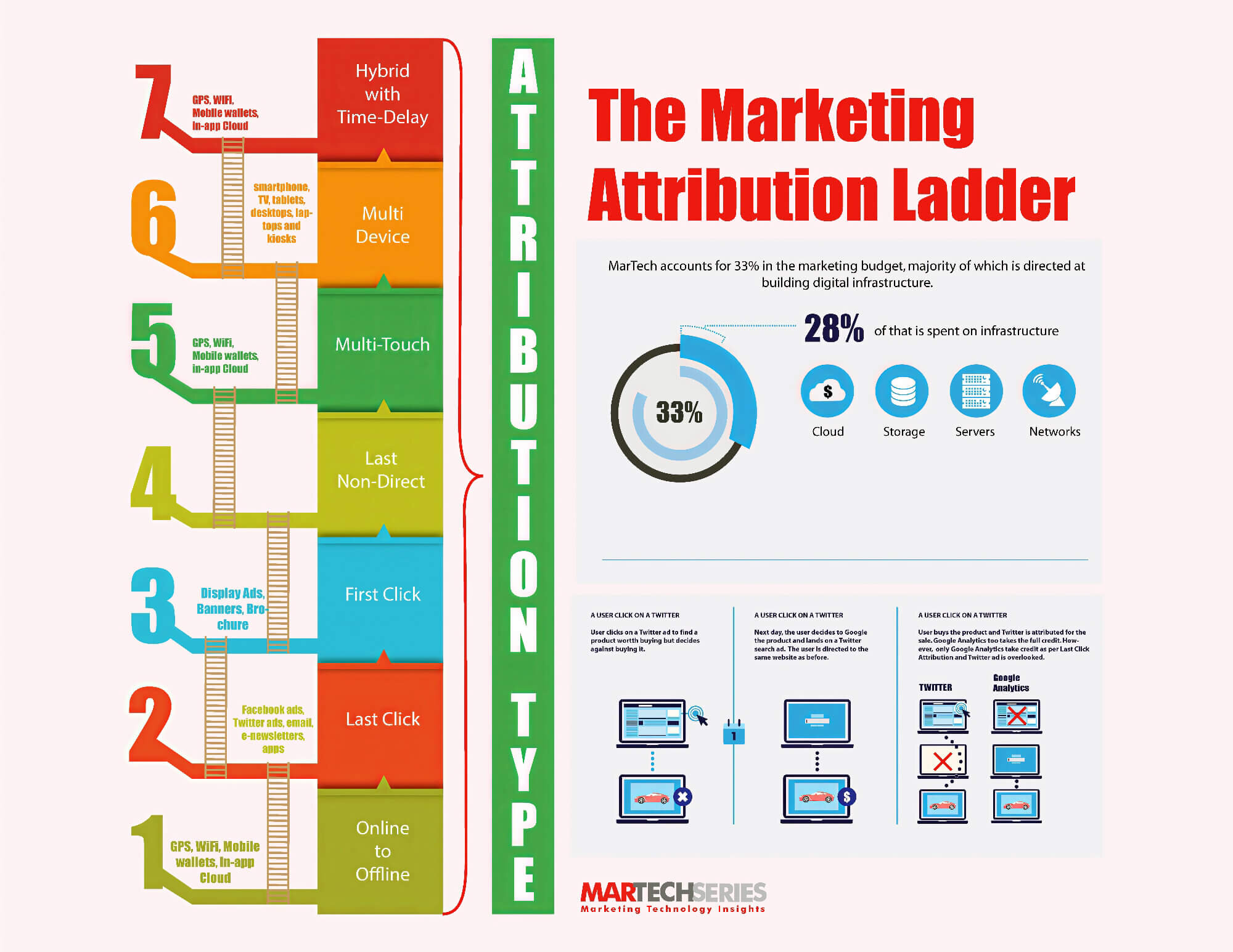
4. Position-Based Attribution
Often referred to as U-shaped marketing attribution, the position-based attribution model is slightly more complex than other models. A position-based attribution model distributes credits across the marketing funnel in the following ways:
- 40% to a visitor’s first touchpoint
- 40% to the last touchpoint that happens just before conversion
- 20% to the rest of the touchpoints that happen in between the two touchpoints
Pros
- Ascribes the credit for conversions to all marketing touchpoints
- It is helpful for brands with several touch points before conversion
Cons
- May undervalue the influence of marketing performances
- Conversion credits may be distributed inadequately
5. Time Decay Attribution
The time decay attribution model assigns conversion credits differently—it gives most credit to later touchpoints, with the first getting less credit and the last getting more credit.
Pros
- Helpful for optimising the most influential touchpoints
- Useful for businesses that rely heavily on relationship-building
Cons
- Not effective for brands with a short sales cycle
6. Custom Attribution
Though complex, the custom attribution model is the most tailored among all models. With custom attribution models, marketers can modify the weights for each position-based interaction, optimise for valuable outcomes, and assign credits to high-value touches.
Pros
- Can be customised as per the needs and goals of clients
- Allows marketers to analyse high-conversion channels
Cons
- Complex to build
B. Single Touch Vs. Multi-Touch Attribution
As understood, single source attribution models assign conversion credits only to one touchpoint in the customer’s journey. Usually, credits are assigned to the first and last touchpoints in a single touch attribution model.
Meanwhile, multi-touch attribution models quantify multiple touchpoints, encompassing everything from e-newsletters to social posts and ads. Because there are a variety of marketing channels that lead to conversions, single-touch attribution models are considered inaccurate and archaic.
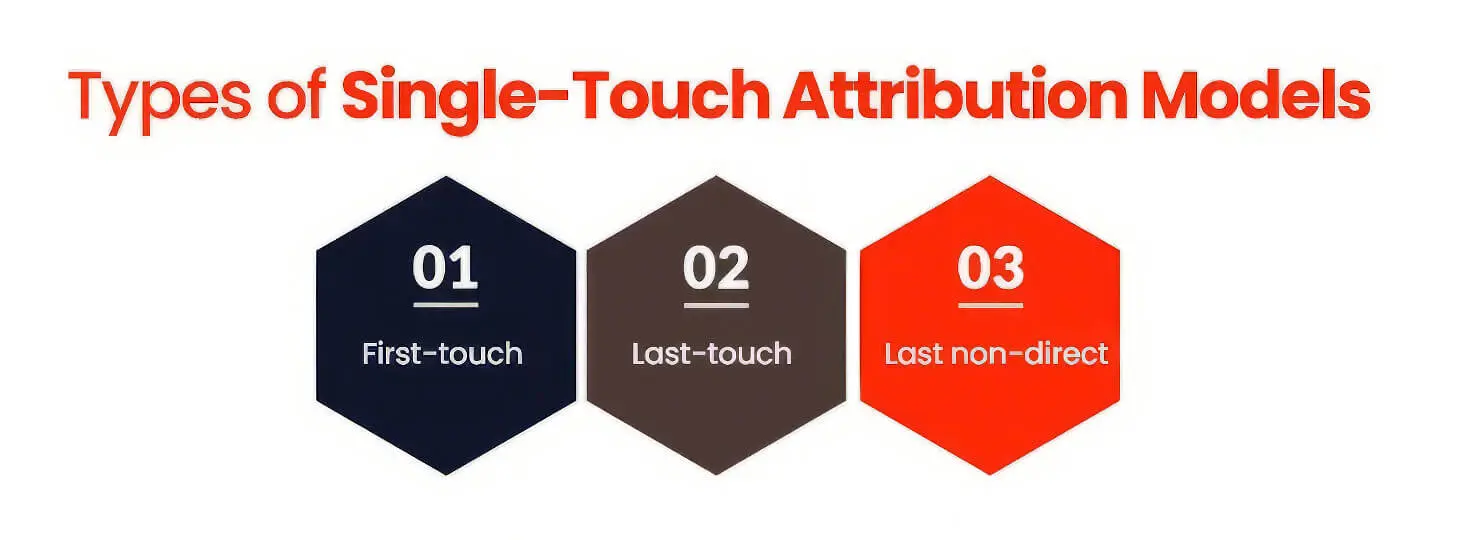
Even though multi-touch attribution models are considered accurate in determining a customer’s journey from prospect to customer, they are difficult to implement. Plus, they often fail to take into account the real contribution made by each marketing channel.
First-touch and last-touch attribution models fall under the single source marketing models, whereas linear, time decay, position-based, and custom belong to multi-touch attribution models.
Why Is Marketing Attribution Important?
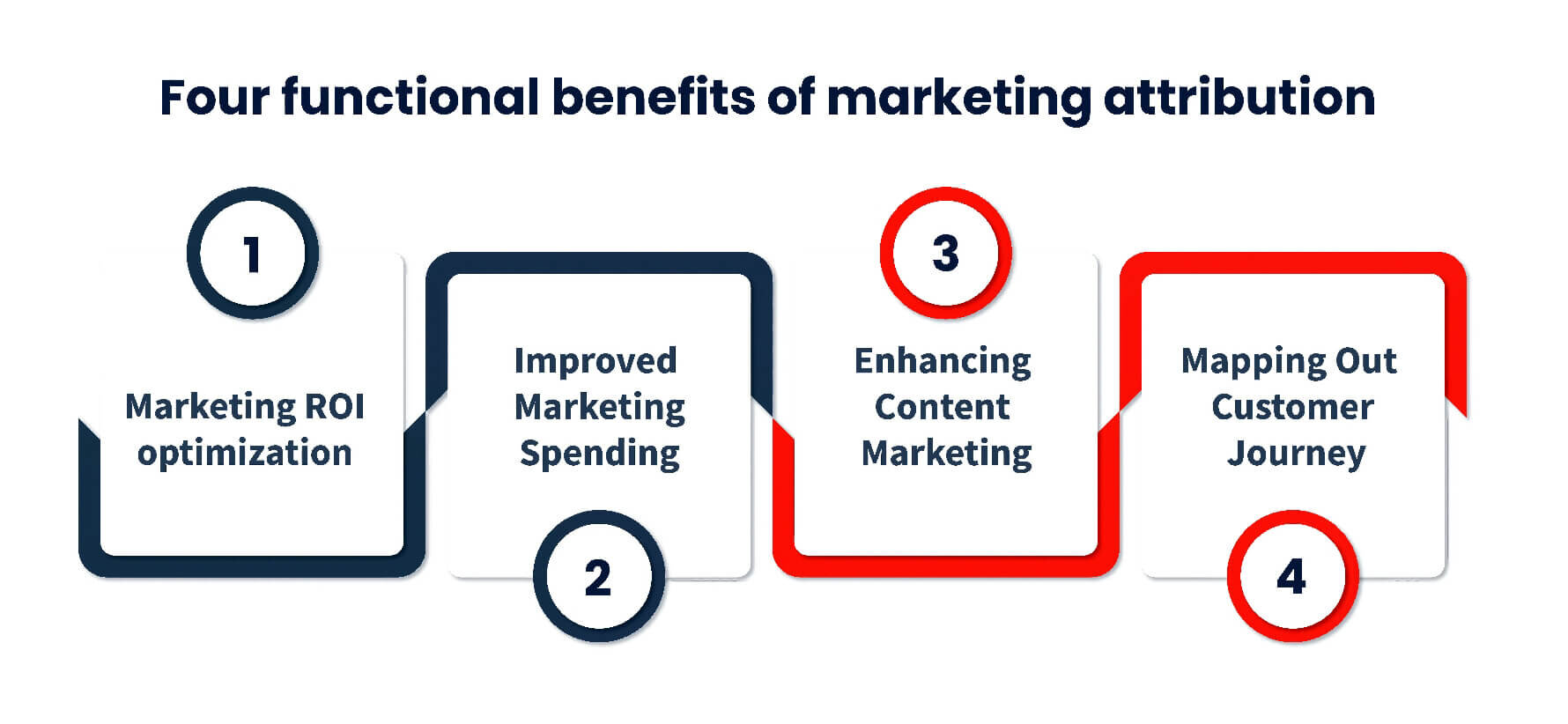
As far as marketing is concerned, knowledge is power. By this, we mean to say that the more you understand your past performance, the better you’ll be able to plan your future marketing tactics.
In simpler terms, marketing attribution helps identify which channels have delivered a high return on investment (ROI), enabling more strategic and effective updates to your marketing strategies for enhanced optimisation.
The goal of attribution reporting is to help businesses comprehend how marketing initiatives encourage audiences to purchase and build relationships with them. In a nutshell, marketing attribution will help businesses understand the following:
- Gaps in the journey of customers
- Recommendations or improvements for future campaigns
- Whether to increase or re-distribute ad spends
- Which marketing channels generated the maximum amount of conversions
Benefits Of Marketing Attribution For Businesses
Developing accurate advanced attribution models can be time-consuming, especially complex models that evaluate a multitude of datasets for both offline and online marketing campaigns. However, this process is vital for sales teams to gain valuable insights. Nevertheless, if you measure marketing attribution correctly, it will help your business in many ways.
With that in mind, let’s dive into why marketing attribution is beneficial for businesses striving to optimise their marketing efforts.
1. Increase ROI
Successful marketing attribution aids marketers in reaching the appropriate audience at the right time with a resonating message, thereby enhancing lead generation. This, in turn, increases the conversion rate and the marketing ROI, improving the company’s reach.
2. Creative Elements
Attribution models enable marketers to refine visual and messaging elements by evaluating the creative aspects of marketing, which is particularly important in the context of social media marketing. In addition to that, they help them gain an understanding of how and when to engage with the audience.
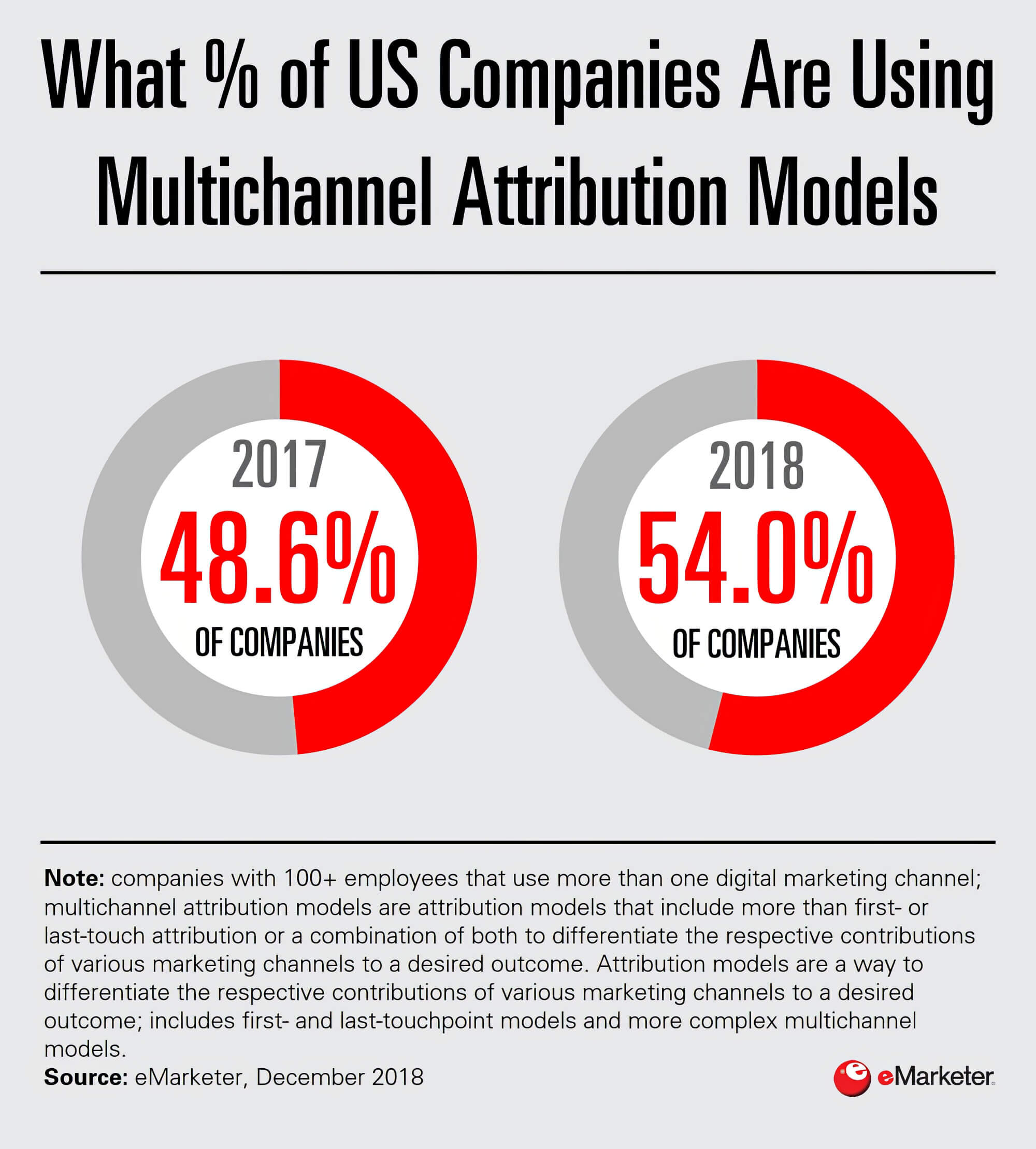
3. Improve Product Development
Implementing a person-level attribution strategy assists a business’s marketing team in better understanding the needs of their current and prospective customers, thereby driving direct traffic to their offerings. The insight gained from such attribution can later be used or referred to when improving products or services to include consumers’ desired features.
4. Improve Personalisation
Data offered by marketing attribution gives businesses and marketers insight into the marketing and messaging channels consumers prefer. Based on these insights, they can target audiences more effectively throughout their journey.
5. Optimise Marketing Spend
Another significant benefit of marketing attribution is that it allows business owners and their marketing teams to optimise marketing spend. It provides them with data for the most effective use of marketing budgets by displaying touchpoints that generate the most engagements.
How To Implement A Marketing Attribution Strategy?
A. Steps To Implementing A Marketing Attribution Strategy
1. Decide The Time Period You Want To Analyse
Deciding what time period you wish to analyse is the first and foremost thing you should do before implementing a marketing attribution strategy. Many businesses opt for monthly attribution reporting, while others prefer weekly attribution reporting.
However, a few businesses use it as a strategic tool, examining data methodically and in detail before making changes.
When you select a time frame, please consider the dates and seasonality because they greatly impact the data. Say your company has an annual sales cycle, and you wish to examine the data of the past few years. When analysing data, you must be careful because too much data can skew the outcome, especially if the sales cycle lasts several months.
2. Find The Right Marketing Attribution Software Or Tools
Collecting accurate data is essential before you start with marketing attribution reporting.
Like many businesses, you may use various marketing attribution tools to monitor your customers’ behaviour before and after they make a purchase. These tools can help collect valuable data from focus groups, surveys, and interviews, playing an essential role in successful marketing attribution.
As you search for data collection tools, consider your business goals and the queries your attribution reports are intended to address.
There are more than 100 attribution reports on Google Analytics for website analysis. But what if you or your client wishes to include user interactions after they sign up in the marketing attribution model? In that case, Google Analytics won’t help much, and you’ll have to look for other tools suited for the purpose.
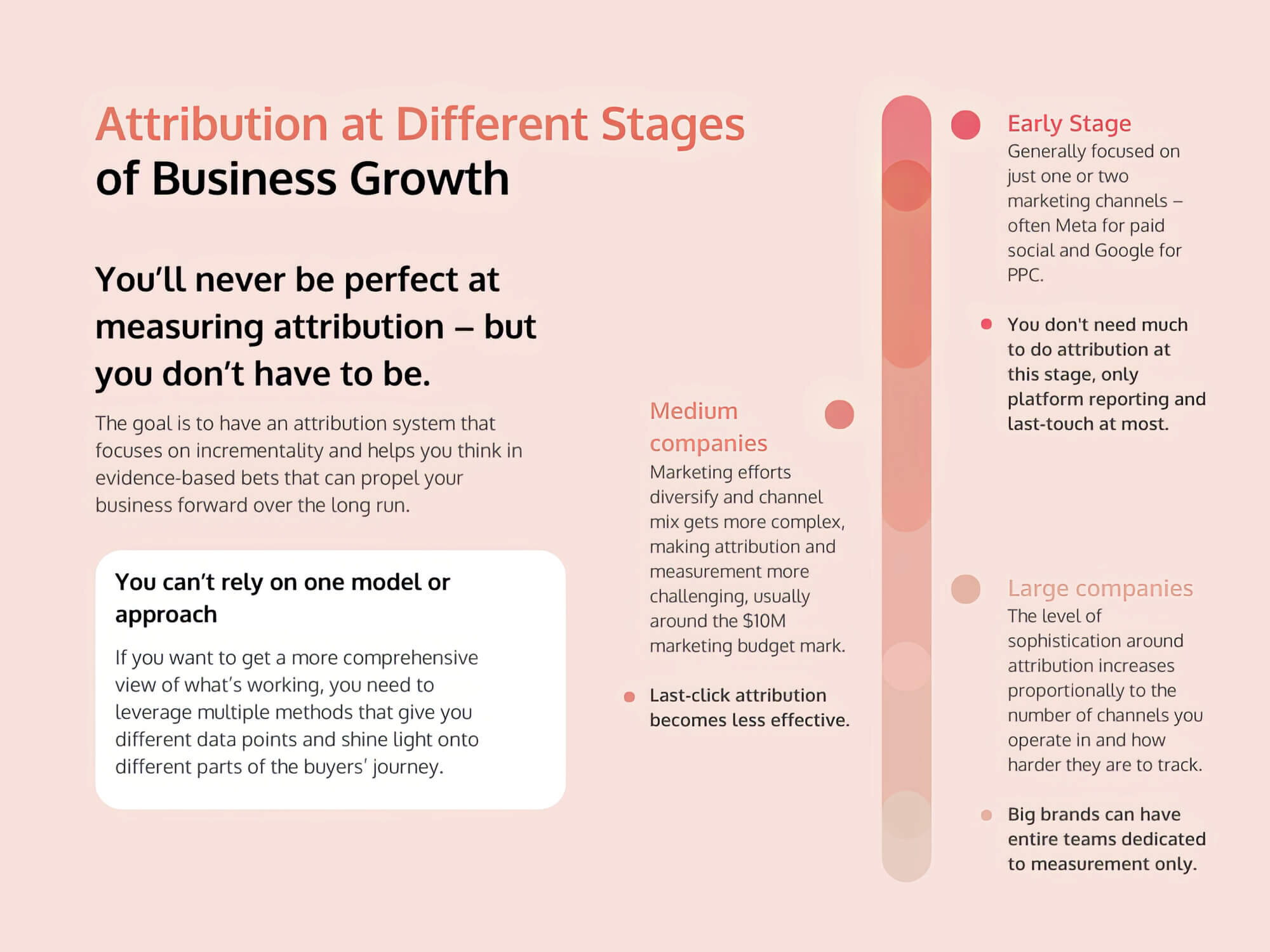
3. Review Both The Buyer Journey And Customer Habits
Data gathered by marketing attribution reports help businesses and marketers determine the kind of content performing better and generating leads. Attribution reports also give an insight into the most viewed pages, allowing businesses to understand which pages they should optimise or promote.
Marketers and businesses use these reports to solve problems. Attribution reports can be used for the following:
- Assess marketing touchpoints
- Recognise gaps or blockers in user experience
- Take down content that isn’t making any difference
4. Evaluate The Attribution Data
After selecting an attribution model, evaluate the data to determine whether the model and the inputs are helpful in answering your key queries. In other words, you’ll be able to understand which digital campaigns or content are helping you achieve your objective.
5. Simplify Your Marketing Attribution So That It’s Easy To Review
To be honest, even seasoned marketers find attribution challenging. That is why you must make efforts to simplify your marketing attribution so that the stakeholders can understand the data without difficulties.
Adding graphics to your marketing attribution report will make it easy to understand. You can do so by leveraging marketing attribution software. As soon as you figure out the gaps between the attribution reporting results and your business goals, you must plan new strategies and start implementing them.
B. How To Choose The Right Attribution Model?
Selecting a suitable attribution model is just as crucial as selecting the right tools for data gathering in the process of attribution modelling.
Several marketing attribution tools can track the full user journey through algorithmic models. However, it’s important to remember that no definitive ‘best marketing attribution model’ fits all scenarios. Instead, utilising a combination of models is often the most effective approach.
That’s because different marketing attribution models help evaluate different sets of data. Let’s take an example: the goal of your brand is to increase brand awareness and widen the sales funnel. In such situations, the first-touch attribution model will provide insight into the touchpoints that attract visitors to your brand.
On the flip side, a multi-touch attribution model will help address the issue of customer retention in your marketing strategy. Several factors that marketers and business owners need to consider when choosing an attribution model are as follows:
1. Sales Cycle
The type of sales cycle your business runs on is an essential factor to consider when choosing a marketing attribution model. Besides type, the sales cycle length should be considered, as it will help you determine which model will be the best fit.
2. Offline Marketing Efforts
Another essential factor to consider is the amount of marketing efforts focused solely offline, such as television, broadcast, or print. Businesses that attribute a lot of importance to offline mediums must choose multi-touch models capable of integrating online activities with offline ones for the most accurate insights.
3. Customer Journey Map
Whether you choose a first-click attribution model or a linear attribution model depends on your goals.
If your interest lies in comprehending your customer’s journey throughout the marketing funnel, employing solely first-click or last-click models would be non-conducive to your marketing strategies. Going for multi-touch or customised models will be helpful in such instances.
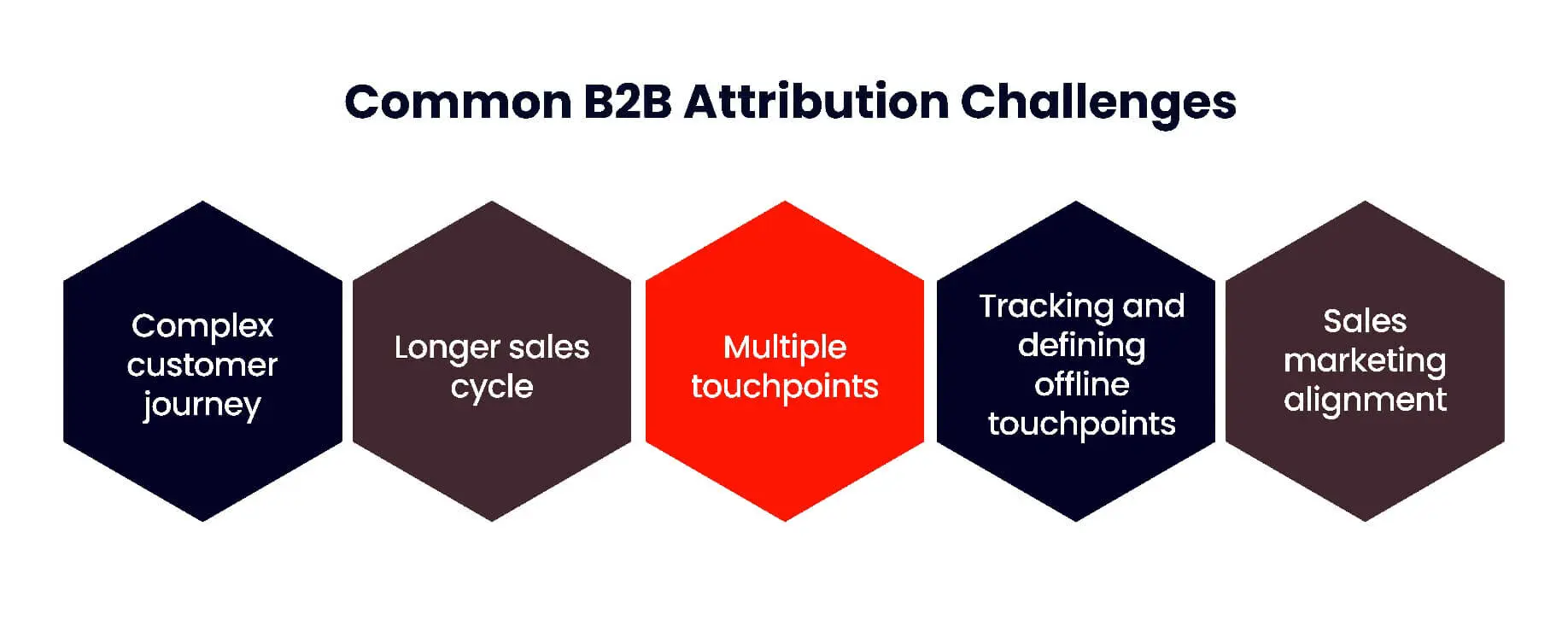
Challenges And Solutions For Marketing Attribution
A. Common Mistakes And Solutions In Marketing Attribution
There’s no denying that attribution offers a host of benefits to businesses. However, at the same time, a few mistakes can mask the success of marketing campaigns.
To ensure that the marketing attribution reflects their user’s journey accurately, here are the common mistakes every business and marketer should avoid, along with the solution:
1. Uneven Conversion Credit Distribution
One common challenge marketers encounter is ensuring that every touchpoint in the customer journey receives adequate conversion credit. Often, leveraging an incorrect attribution model leads to uneven distribution of credit.
Solution: The best attribution model will assign credits by evaluating consumer behaviour properly, preventing misattribution.
2. Inaccuracy
Even a minor error in marketing attribution can lead to inefficiency and inaccuracy, highlighting the importance of reliable attribution technology. When that happens, it can result in confusion, and your decisions based on those reports will negatively impact your business’s bottom line.
Solution: This inaccuracy can be prevented by using the best marketing attribution software because it provides the most accurate information.
3. Capturing Every Aspect Of Customer’s Journey May Be Tricky
Marketing attribution may not capture every facet of the user’s journey at times, making it difficult to decide on future marketing campaigns.
Solution: Only a solid and well-designed marketing attribution strategy will provide insight into every aspect of the customer’s journey. In this regard, hiring expert marketers will be the best bet.

B. Latest Trends And Developments In Marketing Attribution
The business landscape is highly competitive, and the only way to stay ahead of the curve is to keep yourself updated regarding the latest trends and developments. Otherwise, surviving the cut-throat competition will become challenging.
That said, here’s how you must keep yourself updated with the latest trends and developments in marketing attribution:
1. Search Publications
One of the best ways to learn about ongoing trends is to search for marketing publications online. You can also set up Google Alerts on marketing attribution trends, and news will be delivered to your inbox.
2. Read More
Reading books on marketing attribution or watching informational videos will keep you updated about the ongoing trends and developments in the attribution landscape.
3. Podcasts
Listen to podcasts. Podcasts feature industry experts who share their insights, experiences, and tips, offering valuable knowledge that can enhance understanding of marketing attribution models.
4. Competitor Analysis
Keep an eye on your competitors to know the strategies they are leveraging to stay ahead of the competition. Several tools are available; you only need to find the right one.
Unveiling Marketing Attribution for Unparalleled Insights
In summary, marketing attribution involves pinpointing which channels and activities lead to sales or conversions. Beyond just identifying valuable channels, it guides businesses in refining their current marketing strategies and crafting new approaches.
To reap these benefits and increase your ROI, you need to use attribution models built according to your business’s needs. It is difficult to gain bottom-up and top-down insights on pre-built models.
And when you’re finding it all too overwhelming, contact a reliable and experienced marketer, such as sitecentre®, to optimise your marketing campaigns and improve your bottom line.
Frequently Asked Questions
Q1. How do you set up marketing attribution?
Here’s how you can set up marketing attribution:
- Define the goals of your business and what you wish to track
- Decide on an attribution model
- Develop tracking mechanisms to assess the effectiveness of every marketing activity.
- Setup reporting systems
- Adjust campaigns as needed
Q2. How do you select the right marketing attribution tool?
When choosing a marketing attribution tool or software, businesses need to take into account a few factors, and they are as follows:
- Speed of the software
- Accuracy
- Cross-channel marketing insights
- Relationship between performance and branding
Q3. Why should chief marketing officers consider marketing attribution?
Often, chief marketing officers or CMOs are pressured to achieve better results without spending a lot of marketing budget. Conversely, the customer’s journey has become complicated, and marketing attribution is a valuable tool for CMOs. It can help them in the following ways:
- Help them gain a deep understanding of user interactions and behaviour
- Calculate and track the impact of their marketing effort
- Distribution expenditures carefully to generate better results
- Make better decisions based on the data offered by the models




